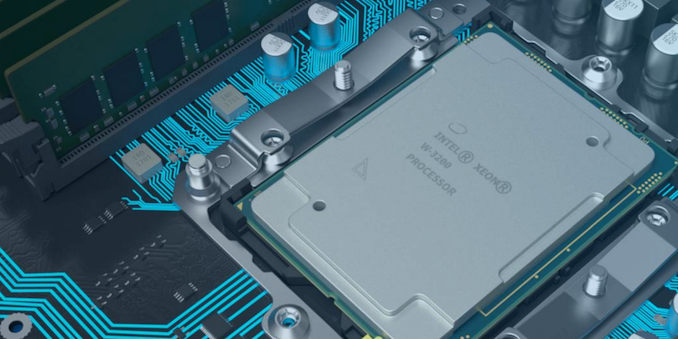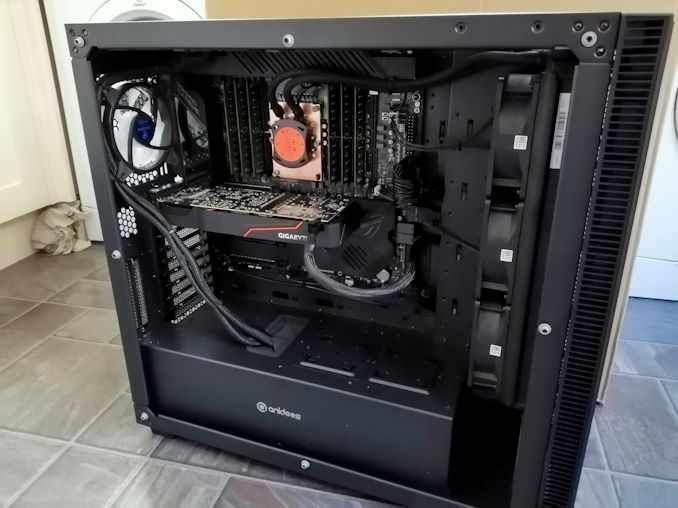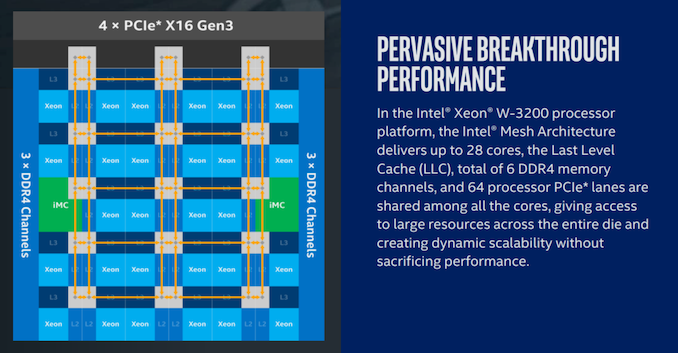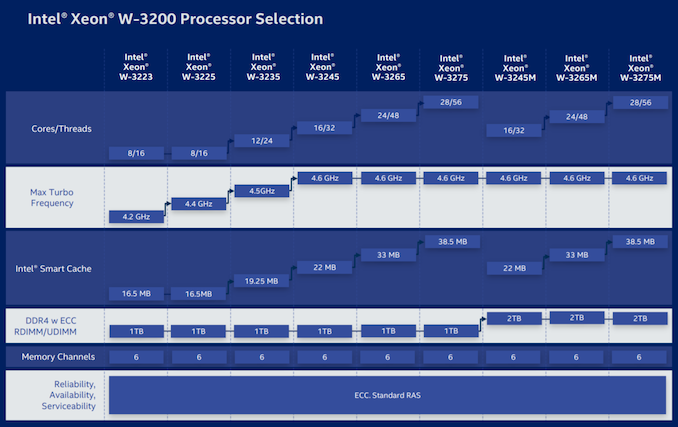Intel Cascade Lake Xeon W-3200 Launched: Server Socket, 64 PCIe 3.0 lanes
by Dr. Ian Cutress on June 10, 2019 8:00 AM EST
One of the quiet announcements that came out of Apple’s new Mac Pro announcement was the launch of Intel’s next generation Xeon W processors. Aside from being completely under the radar from a formal announcement, the new line of workstation focused CPUs heralds a few quirks: they are Cascade Lake based, they are only in the LGA3647 socket, and they have 64 available PCIe 3.0 lanes.
The current Xeon W product line, based on Skylake-SP, uses the common high-end desktop socket LGA2066, but with a workstation focused chipset. These processors are available up to eighteen cores, using Intel’s HCC 18-core die as the highest it will go. The other features of these processors include quad channel memory, 512GB ECC support, and up to 48 PCIe 3.0 lanes. What Intel has done for the next generation has bump it up to the server socket, which affords more memory channels, higher TDPs, more memory supported, and a higher core count.
The new Cascade Lake-based Xeon W-3200 family will be offered up to 28 cores, using Intel’s XCC 28-core die as the base for the high-end models. As a Cascade Lake processor, the new Xeon W will come with additional in-hardware fixes for some of the Spectre and Meltdown vulnerabilities, similar to the Cascade Lake Xeon Scalable Processors. Intel has also made a substantial change in the way that it intends to market its Xeon W processors, as the new models also change socket compared to the previous generation.
Historically we are afforded multiple generations of workstation CPU on the same socket, however at this time Intel has decided to forgo this application and move Xeon W from the LGA2066 socket to the LGA3647 socket, limiting users who wish to upgrade from their Xeon W-2100 processors. The new socket, combined with the new silicon, means that Intel can offer new Xeon W owners more features, although much to the chagrin of previous Xeon W owners. This doesn't exclude Intel launching another set of CPUs on the LGA2066 socket for upgrades, however given the lack of fanfare for this launch, it wouldn't seem likely that Intel has plans to do so.
The LGA3647 socket has been used in Xeon Scalable processors since Skylake-SP launch, and affords six full DDR4 memory channels. The silicon inside the new Xeon W does have six memory controllers, allowing it to take full use of this feature. (Technically the previous generation also had six memory controllers in the silicon, but the platform was limited to four, as per Intel’s product positioning strategy.)

The LGA3647 system Intel sent with the last Xeon W Review Unit
As with the previous Xeon W, the cores are arranged in a block, and inside is a ‘Mesh’ which we’ve described in detail in previous reviews. One of the additional features for the Xeon W-3200 is the upgrade to a full 64 PCIe 3.0 lanes available for PCIe slots, up from the previous 48. This also makes Intel’s new Cascade Lake W-3200 family the x86 product that Intel offers with the most PCIe lanes.
This is a bit of a technicality – previous Xeon SP and Xeon W did actually have 64 lanes on the silicon, however 16 of them were reserved for on-package chips, such as OmniPath. What Intel has done here is re-route them through the socket pins instead, allowing motherboard manufacturers to design a full x16/x16/x16/x16 layout or variants therein. This also means that the LGA3647 socket already had pins ready to be allocated to these PCIe lanes, so it would not have surprised me if Intel has already sold 64 PCIe lane custom versions to customers since the original Skylake-SP launch.
Here are the nine new CPUs:
| Intel Cascade Lake Xeon W-3200 Family | |||||||
| AnandTech | Cores Threads |
TDP | Base Freq |
Turbo 2.0 |
Turbo 3.0 |
DRAM | Price |
| W-3275M | 28C / 56T | 205 W | 2.5 GHz | 4.4 GHz | 4.6 GHz | 2 TiB | $7453 |
| W-3275 | 28C / 56T | 205 W | 2.5 GHz | 4.4 GHz | 4.6 GHz | 1 TiB | $4449 |
| W-3265M | 24C / 48T | 205 W | 2.7 GHz | 4.4 GHz | 4.6 GHz | 2 TiB | $6353 |
| W-3265 | 24C / 48T | 205 W | 2.7 GHz | 4.4 GHz | 4.6 GHz | 1 TiB | $3349 |
| W-3245M | 16C / 32T | 205 W | 3.2 GHz | 4.4 GHz | 4.6 GHz | 2 TiB | $5002 |
| W-3245 | 16C / 32T | 205 W | 3.2 GHz | 4.4 GHz | 4.6 GHz | 1 TiB | $1999 |
| W-3235 | 12C / 24T | 180 W | 3.3 GHz | 4.4 GHz | 4.5 GHz | 1 TiB | $1398 |
| W-3225 | 8C / 16T | 160 W | 3.7 GHz | 4.3 GHz | 4.4 GHz | 1 TiB | $1199 |
| W-3223 | 8C / 16T | 160 W | 3.5 GHz | 4.0 GHz | 4.2 GHz | 1 TiB | $749 |
Each CPU also supports AVX512, with two FMA units across every model. Memory support for all CPUs is listed as six channels of DDR4-2933 (except the 8 core parts , which are DDR4-2666), with a base support of 1 TiB of memory which rises to 2 TiB for the higher memory models (for an additional $3000). This also marks the first instance in which Intel is offering higher memory support SKUs for Xeon W, although it should be noted that Intel seems relatively happy these days to allow support of unbalanced memory configurations. E.g. 1 TiB split between 12 memory slots means 8 x 64GiB + 4 x 128 GiB module arrangements, or 2 TiB means 8 x 128 GiB + 4 x 256 GiB.
Another feature making its way onto these CPUs is Turbo Boost Max 3.0, which is an additional turbo setting on each CPU if the situation allows it. It should be pointed out that in-line with other workstation CPUs, these models are only built for single socket systems.
One interesting feature missing from these CPUs is Optane DC Persistent Memory support. Intel had stated at its Investor Day presentations that Optane DC Persistent Memory support was coming to the workstation processor line by the end of the year. This means that either Intel is planning another Xeon W update between now and Q1 2020, or this feature may be BIOS enabled later in its lifecycle. The other alternative is that Intel will offer Optane capable custom SKUs for specific customers.
Intel’s new Cascade Lake Xeon W processor line is currently available in the new Apple Mac Pro. We expect it to filter down into other platforms over the next two quarters, and perhaps become more widely available at retail.
| Want to keep up to date with all of our Computex 2019 Coverage? | ||||||
 Laptops |
 Hardware |
 Chips |
||||
| Follow AnandTech's breaking news here! | ||||||













56 Comments
View All Comments
ZoZo - Monday, June 10, 2019 - link
Now that TR4 motherboards with IPMI are appearing, I guess I can aim at/hope for any new Threadripper line-up. 64 to 128 lanes of PCI-E 4.0 with ECC and unlocked multiplier, all for a lower price, sounds quite sweet.Vlad_Da_Great - Monday, June 10, 2019 - link
NEXT year.Kevin G - Wednesday, June 12, 2019 - link
I wouldn't expect a massive IO bump but a small one is certainly within reason: AMD increased the number of PCIe lanes from 128 to 130 on Epyc. Why? Vendor feed back regarding storage and IPMI IO. Most IPMI and associated IO take up to PCIe lanes which left 126 for usage. Epyc was great for lots of NVMe drives but was limited to 31.5 at full 4x PCIe 3.0 bandwidth. Those extra two lanes bring that figure up to a nice clean 32 drive without sacrificing IPMI.For Theadripper, something similar exists: 60 usable PCIe lanes. I can see this being bumped up to 64 or 66 so that four full 16x PCIe 4.0 slots are possible.
mode_13h - Friday, June 21, 2019 - link
If you want 128 lanes of PCIe, I think you'll need to buy EPYC. They need to keep some product differentiation between these two, and I don't see why PCIe lane count wouldn't continue to be part of it.AdditionalPylons - Monday, June 10, 2019 - link
Apple interestingly sums up L2 and L3 amounts on their stated "cache size" on their website. The SKUs used in the Mac Pro are most likely the following:28-core: Xeon W-3275M, $7453 (compared to $4449 for the non-M version with max 1 TB RAM)
24-core: Xeon W-3265M, $6353 (for $3349 non-M version)
16-core: Xeon W-3245, $1999
12-core: Xeon W-3235, $1398
8-core: Xeon W-3223, $749
With the choices of 24 and 28-core models, Apple is assuming people who need the higher CPU performance also need more than 1 TB of RAM. There are extremely few use cases that need more than 128 GB of RAM, so I think there should be options for non-M versions too, in order to save those $3000.
Skeptical123 - Monday, June 10, 2019 - link
This makes the $20k+ estimates for the new topped out Mac pros seem a little reasonable. Since the the highest CPU you can get from apple might cost up to $7453 list price alone. Though the $6k base price for the 8-core, 32GB of RAM, a single Radeon Pro 580X GPU, and a 256GB SSD seems a more crazy if the cpu list cost is $749, a a few hundred each for the ram, ssd, cpu and your at best around 2k... I guess regardless of the "Apple Tax" Apple is pricing this machine to make more cost since for upgraded version. Which I assume is want professionals will want anyway if they are in able to afford this price bracket :)MattZN - Monday, June 10, 2019 - link
Intel is smoking something if they think they can compete against threadripper at those prices. Intel still wants people to believe that an 8-core processors is the bees-knees. Oh yah... and yet another socket change. The only thing decent about these CPUs is the memory support... but still, by taking away the socket upgrade option I wonder how Intel could possibly believe that anyone would want to build completely new systems around this new form factor.-Matt
mode_13h - Tuesday, June 11, 2019 - link
I think most workstation users don't upgrade their CPU from one generation to the next. The only case for this would be if you buy-in at a low core count and go for more cores + newer gen. But, honestly, most workstation users probably never even open their case. A big upgrade for them would be the SSD or the GPU.The bigger issue is for OEMs, who get only one CPU generation to reap the investment they put into system design & qualification. It might help that Intel is reusing a server socket for this, but of course with some pin-out changes to handle the extra PCIe lanes (probably re-purposing the UPI pins, since these are single-socket systems).
mode_13h - Tuesday, June 11, 2019 - link
Hmmm... the 3000-series' Max Turbo only goes up to 4.4 GHz, while some members of the 2000-series could reach 4.5 GHz.I don't know what I'd do with 48 lanes. All I really wanted was 20 CPU-connected lanes + DMI, like the original E3-series had. Then, I could plug my GPU in a x16 slot and my SSD in a x4 CPU-direct slot.
And I'll stick with a ring-bus, thank you. Mesh scales better, but I don't currently fancy more than about 8 cores.
With all this said, it should come as no surprise that I'm keenly interested in Ryzen 3000. I just wish they made an 8-core SKU with turbos as high as their 16-core can reach. I'd pay extra for that, but I'm sure they're binning their best dies for EPYC and the 16-core SKU.
AshlayW - Tuesday, June 11, 2019 - link
Yes, something like a 3850X with 4.7 GHz Turbo, maybe even 120W TDP or something to give it room to stretch its legs a bit. maybe $449, right between 3800X and 3900X but basically an 8/16 with maximum possible bin/clocks out of the box.